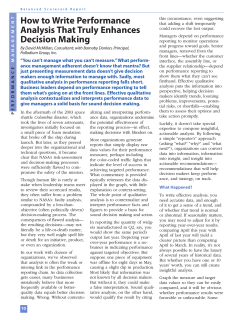
Health Information System Implementation: A
Linköping University Post Print Health Information System Implementation: A Qualitative Meta-analysis Bahlol Rahimi, Vivian Vimarlund and Toomas Timpka N.B.: When citing this work, cite the original article. The original publication is available at www.springerlink.com: Bahlol Rahimi, Vivian Vimarlund and Toomas Timpka, Health Information System Implementation: A Qualitative Meta-analysis, 2009, Journal of medical systems, (33), 5, 359368. http://dx.doi.org/10.1007/s10916-008-9198-9 Copyright: Springer Science Business Media http://www.springerlink.com/ Postprint available at: Linköping University Electronic Press http://urn.kb.se/resolve?urn=urn:nbn:se:liu:diva-15673 Health Information System implementation: A qualitative meta-analysis Bahlol Rahimi MSc1,2 Vivian Vimarlund PhD1 Toomas Timpka MD, PhD1,3 1 Department of Computer and Information Sciences, Linköping University, Linköping, Sweden 2 Department of Social Medicine, Urmia University of Medical Sciences, Urmia, Iran 3 Department of Social Medicine, Linköping University, Linköping, Sweden Abstract: Healthcare information systems (HISs) are often implemented to enhance the quality and patient-centeredness of care, as well as to improve the efficiency and safety of the services. However, the outcomes of HISs implementations in both primary care and hospital settings have not met expectations. Research reports indicate that there is a need to study HISs implementation process and its organizational consequences. The aim of this paper has been to organize the knowledge gained in qualitative studies performed in association to HIS implementations and to use this knowledge to outline an updated structure for implementation planning. We found that the main action implication that could be drawn from the meta-analysis was that merely implementing a HIS will not automatically increase the organizational efficiency. We used a multi-disciplinary team for the analyses in order to cover as many aspects of the primary studies as possible. Nevertheless, our results should be interpreted as a high-order scheme, and not a predictive theory and the action recommendation need to be investigated in prospective studies. The results obtained shown that when implementing HISs in hospital and primary care environments, at a minimum, strategic, tactical, and operational actions have to be taken into consideration, through management involvement, integration in healthcare workflow and specially user involvement, education and training and through establishing compatibility between software and hardware. The results show also that many of the most important failures seem still to emerge from the absence of feedback from end–users to developers during the development process. What it is needed is the use of an implementation methodology that minimizes the information asymmetry in the implementation process, and that allows the accumulation of the knowledge capital needed to prevent rejection of the final system Keywords: health information system, implementation, failure Introduction Healthcare information systems (HISs), such as computerized physician order entry (CPOE) and computer-based patient records (CPRs) have been implemented to enhance the quality and patient-centeredness of care, as well as to improve the efficiency and safety of the services (1). However, the outcomes of HIS implementations in both primary care and hospital settings have not met expectations. A number of research reports indicate undesired consequences (2, 3, 4, 5), also pointing out that implementation failures affect negatively the return of investments (6). In consequence, hospital managers have today realized that they may overlook interplays between the HIS and organizational performance, and in particular individual users‘ needs, problems, and demands, if they uncritically trust the promises made by vendors (7). This situation implies that there is an urgent need to make the best possible use of the scientific knowledge available about HIS implementation processes and their organizational consequences. Starting with a number of groundbreaking studies in the 1990ies (8,9), qualitative research has during the last decades progressively gained interest among researchers in health informatics). Nevertheless, the results from qualitative studies are often interpreted in isolation not exploiting productive links to previous research. McCormick et al. (2003) point out that although isolated qualitative studies are discussed in literature reviews in health informatics, much qualitative research is not optimally compared and integrated, thus failing to meet its full potential for knowledge development and theory building (10). The aim of this paper is to organize the knowledge gained in qualitative studies performed in association to implementation of HISs and to use the organized knowledge to outline an updated structure for implementation planning. Qualitative meta-analysis methods are used for the knowledge organization. Methods We used qualitative meta-analysis methods to identify areas that commonly have been identified to contain key issues for the implementation of HISs. A qualitative meta-analysis is a type of structured qualitative study that uses as data the findings from other qualitative studies linked by the same or a related topic (11,12). Specifically, we used the seven-step meta-analysis process introduced by Noblit and Hale (13) and further developed by Atkins et al (14). Table 1. Criteria used to select publications to be included in the qualitative meta-analysis (adapted from Atkins 2008). Study evaluation criteria 1. Is this study qualitative research? 2. Are the research questions clearly stated? 3. Is the qualitative approach clearly justified? 4. Is the approach appropriate for the research question? 5. Is the study context clearly described? 6. Is the role of the researcher clearly described? 7. Is the sampling method clearly described? 8. Is the sampling strategy appropriate for the research question? 9. Is the method of data collection clearly described? 10. Is the data collection method appropriate to the research question? 11. Is the method of analysis clearly described? 12. Is the analysis appropriate for the research question? 13. Are the claims made supported by sufficient evidence? Qualitative studies published between January 2003 and March 2008 that discussed effects of the implementation of HIS in hospitals or in primary care were defined to be included in the analysis. The EntrezPubMed database was searched using the keywords implementation, health information system, computerbased/computerized patient records, electronic medical records, computerized physician order entry, and qualitative methods. The quality criteria suggested by Aitkins et al (14) was used to primarily assess the identified studies (Table 1). In addition to the quality assessment, studies that only discussed technical constraints were excluded. The final data set comprised 17 articles of sufficient quality that addressed success and failure factors of HIS implementation process (appendix 1). Table 2: Definitions of terms used to describe the meta-analysis process (adapted from Atkins et al 2008). Term Definition 1st order construct Constructs that reflect participants' understandings, as reported in the included studies (usually found in the results section of an article). 2nd order construct Interpretations of participants' understandings made by authors of these studies (and usually found in the discussion and conclusion section of an article). 3rd order construct The synthesis of both first and second order constructs into a new model or theory about a phenomenon Reciprocal translation The comparison of themes across papers and an attempt to "match" themes from one paper with themes from another, ensuring that a key theme captures similar themes from different papers Line of argument The development of a new model, theory or understanding by synthesising and interpreting synthesis first and second order themes found in the text. Initially, only 1st order constructs were collected from the study reports (Table 2). The 1st order constructs were checked against each other and 2nd order constructs (interpretations presented in the discussion section of the reports). This was done both for validation purposes and to relate our results to results from similar studies. Hereby, a set of areas of relevance for the implementation process were identified. The areas were mainly distinguished through their different operating mechanisms. Thereafter, the 1st order and 2nd order constructs in each area were synthesized in a reciprocal translation process into 3rd order constructs to produce a coherent line of argument. Finally, an outline of an updated structure for implementation planning was constructed by relating the resulting line of argument to action alternatives at strategic, tactical, and operative levels. Results In the synthesis, eleven areas were identified as being important for the implementation of HISs (Table 1). These areas can be divided into three domains with regard to the time span of decision-making: a) The long-term strategic domain: management involvement, motivation and rationales, surveillance of system effectiveness, information needs assessments, b) The medium-term tactical domain: education and training support, the implementation process and methods, work routine and workflow integration, system integration, and c) The day-to-day operational domain: trust, participation and user involvement, technical system performance. Implementation process Management support Work routines and workflow Littlejohns et al. 2003 (15) CPR South Africa Interview, questionnaire (-) (-) (-) (-) (-) Ruland et al. 2003 (16) Törnvall et al. 2004 (17) CPR Norway CPR Sweden Interview, focus group, documents Survey Primary care, and hospital Hospital Primary care (-) Malato et al. 2004 (18) Poon et al. 2004 (19) OdhiamboOtieno et al. 2005 (20) CPOE USA Hospital (-) CPOE USA Interview, observation Interview HIS Kenya Interview, observation, document Primary care Bryson et al. 2005 (21) HIS UK Survey primary care, hospital Pizziferri et al. 2005 (22) EHR USA Observation, survey Primary care Kamadjeu et al. 2005 (23) CPR Cameroon Observation, interview Primary care Scott et al. 2005 (24) EHR USA Interview Primary care, hospital Lee ting-ting 2005 (25) Lapointe et al. 2006 (26) CPR Taiwan Questionnaire Hospital CIS Canada observations, document and interviews Hospital Paré et al. 2006 CPR Canada Survey Hospital (+ ) (+) (-) (+) (+) (-) (+) (-) (-) (-) (-) (-) (-) (-) (-) (+) (+) (-) (+) (+) Hospital (-) (-) (-) (-) (-) (-) (-) (+) (-) (+) (+) (+) (-) (-) (+) System effectiveness Information need assessment Factors identified as important for the implementation of HIS Participation and user involvement Domain Technical system performance Data collection method Trust Country Integration of the system Type of the system Motivation and rationales Authors Education and training support Table 3. Factors identified as important for the implementation of HIS (-) (-) (+) (+) (+) (-) (-) (-) (+) (+) (+) (-) (-) (-) (-) (-) (+) (+) (27) Møller-Jensen et al. 2006 (28) CPR Denmark Questionnaire, interviews, observations Interview, questionnaire Hospital Machan et al. 2006 (29) CPR Austria Hospital (-) Ash et al. 2007 (30) Samoutis et al. 2007 (31) CPOE USA Survey hospital (-) (-) (-) EMR Cyprus Questionnaire, documents, interview Primary care (-) (-) (-) (-) Rahimi et al. 2008 (32) CPR Sweden Interview, document Primary care (-) (-) (+ ) (-) (- ) (+) (-) (+) (+) (+) (+) (+) (-) (-) (-) (-) (-) In the long-term strategic domain, HIS implementation was found to require careful planning from the management. In turn, an effective contribution from the management to the implementation process was dependent on continuous supply of information about the system performance. Similarly, when organizational objectives are altered, there is a need to adjust the implementation plans accordingly. If the management in these situations cannot supply the implementation process the additional resources or competences needed, the process is likely to fail (15, 29). Moreover, opening up for continuous improvements was found to be important not only during the de facto HIS implementation, but also after the system formally had been introduced. This was due that healthcare environments undergo constant modifications, leading to that technical adjustments have to be handled in order to maintain optimal system performance. If the management underestimates the complexity of clinical routines and the importance of end-users being involved in the implementation process, inefficiencies may result that affect the organizational performance of the HIS and staff confidence in the system (15, 32). In the medium-term tactical domain, it was found that the views on how to fit the system into the clinical workflow often differed between systems developers and managers, on the one hand side, and clinical teams, on the other (30). At hospitals and primary care centers, it is often anticipated by clinical administrators that the can HIS offer an overview of all patients cared for by the practitioners. However, such overviews have to employ and aggregate data from a large and diverse set of separate clinical systems and information from different care givers. To implement such ‗general-purpose‘ HIS that meets the needs of both clinical planning and patient practice has been found difficult (20, 31). The strengths and weakness of a system implementation depends upon the value they offer to end-users, and important trade-offs between tasks and user groups must be consciously considered. In the day-to-day operational domain, it was observed in cases when the motivation for implementing the HIS was other than improving the quality of patient care that practitioners tended to resist using the system (26, 30, 31). Such resistance was also related to whether clinicians had been involved in the design and implementation or not. Harmonization between organizational and individual clinical goals at the level of day-to-day practice was thus found to be important, principally because the interpretation of the usability of the new system can differ between stakeholders and practitioners (15, 19, 29, 30). Moreover, participation and collaboration across user groups was found to be critically associated to successful clinical system implementation (15, 17, 18, 21, 27, 32). Professionals from medicine, nursing, and laboratory disciplines have to learn to collaborate in a HIS environment and acquire personal experiences about the reliability of the system functions, e.g. e-prescriptions and networked image management. Otherwise, a perception that technical system deficiencies reduce the quality of clinical routines can result, that interferes with the possibility to increase effectiveness of the clinical services. Action implications for implementation planning The major action implication derived from the meta-analysis was that HIS is a means and not an end, i.e. that merely implementing a HIS will not automatically increase the efficiency of a clinical organization. The system is a tool for establishing a process that is used to continuously improve clinical and administrative operations. Expecting a HIS implementation to solve organizational problems is akin to adopting performance measures but neglecting to check on the progress of the performance data. Therefore, top management must understand when implementing a HIS that there are certain things that cannot be compromised for achieving system adoption and project staff must envision critical healthcare process weaknesses at the outset of implementation in order to take preventive action, and fully realize the potential of the system. When implementing HIS in hospital and primary care environments, the results of the meta-analysis suggests that, at a minimum, the following strategic, tactical, and operational actions are taken into consideration: Strategic actions Management involvement: The roles of managers in HIS implementation should include developing an understanding of the capabilities and limitations of the HIS, establishing reasonable goals for the HIS, exhibiting strong commitment to the successful introduction of HIS, and developing and communicating the IT strategy to all clinical staff. In addition to this, it is necessary to allocate recourses to the implementation efforts and to clearly define goals for the HIS and the organization to be achieved in the short and long time perspectives. Tactical actions HIS integration in healthcare workflow: The system implementation must be performed using a re-engineering perspective. Re-engineering means in this context considering the extent at which hospitals and primary care organizations need to adjust their work processes in order to be able to optimally utilize HIS functions. There are, notably, two kinds of healthcare processes, i.e. those related to operational functions and infrastructure, respectively. Operational processes help accomplish typical clinical functions, such as medical services, and patient support. Infrastructural processes are more administrative, e.g. establishing and implementing strategy and managing human resources, physical assets, and information systems. The HIS needs to integrate in both these types of processes. Operational actions User involvement: When participating in the system implementation, the users go through a transition period that gives them time to learn and appreciate the outcome of the system implementation. Establishing compatibility between software and hardware: management and system developers must choose HIS software that matches the legacy systems, e.g. the hardware platform, databases and operating systems. Education and training: Hospitals and primary care organizations can only benefit from HIS implementations if their staffs utilize the system. For this reason, factors that promote individuals to use the HIS, such as adequate education and training, are also factors that influence the organizational performance when the system is implemented. Discussion The aim of this paper was to organize the knowledge gained in qualitative studies performed in association to HIS implementations and to use this knowledge to outline an updated structure for implementation planning. We found that the main action implication that could be drawn from the meta-analysis was that merely implementing a HIS will not automatically increase the organizational efficiency. Already in the 1990s, Silverstone pointed out that the availability of personal computers in homes had transformed them from being tools for distance workers to being technical device used by essentially everybody in the household (33). In other words, the technology became integrated into people‘s daily life and domesticated in parallel to the evolution of the use patters. Also our results suggest that implementation of technical innovations, in our case in the healthcare context, has to be seen as a process, where social, organizational and economical factors influence the process. Moreover, the results show that there are a number of major issues that lead to inefficiencies in the present implementation practice. These issues start with the lack of understanding among managers of what users need, and move to the purchase or implementing of HIS whose design or functionalities do not support organizational workflow or users work routines. Approaches from many disciplines have been used to understand the processes by which HIS adoption occurs, identifying barriers to implementation success, and suggesting strategies to avoid or to resolve these problems (3, 19, 34, 35). However, the reality of practice still reflects a gap between expected system effects and real world outcomes. The challenges we have described maybe forst and foremost reflect a lack of collaborative approaches in the implementation of HISs. For instance, many of the most important failures seem still to emerge from the absence of feedback from end–users to developers during the development process (36, 37, 38, 39). It is seems therefore rational to increase the involvement of end-users in the implementation process in order to provide: designers new and better ways of gaining an understanding of user's everyday work practices, users, the opportunity to redesign and evaluate their work routines by applying the experience obtained during the participation process (40), and Give the users the opportunity to appreciate the HIS as a tool in their daily work life. In fact, what it is needed is the use of an implementation methodology that minimizes the information asymmetry in the implementation process, and that allows the accumulation of the knowledge capital needed to prevent rejection of the final system (37). Reis et al (2003) has pointed out that ―although meta-analysis of quantitative research is a well-established technique, the synthesis or aggregation of qualitative studies remain rare and controversial.‖ (41) We agree to this statement, but want still to draw attention to some critical sequences in the analysis processes. The sequences include the shaping an appropriate question for the synthesis; identifying the relevant studies; assessing the quality of the studies; and synthesizing findings across large numbers of primary studies from different contexts and research traditions. There are inherent challenges associated to the synthesis of qualitative research, e.g. that the studies included in the analysis may draw upon different theoretical underpinnings, ranging from ethnography to phenomenology. This means that it is not straight-forward to critically appraise the quality of the primary sample of texts using only general guidelines (42). We tried to optimize the rigor in the analysis specifically by focussing the research question and inclusion norms in order to set the boundaries for the analysis (Aitkins 2008). In addition, we used a multi-disciplinary team for the analyses in order to cover as many aspects of the primary studies as possible. Nevertheless, our results should be interpreted as a high-order scheme, and not a predictive theory and the action recommendation need to be investigated in prospective studies. This paper offers an overview of areas where issues can produce unexpected consequences during the implementation of HISs. Many of these consequences, both positive and negative, cannot be anticipated during the system design phase. Further, the results highlight the necessity to ―domesticate and integrate‖ the new HIS in the organization daily work practices (34). Therefore, the use of approaches that accelerate the domestication of the technology and thus the integration of HIS in individuals‘ daily work routines should be emphasized during the implementation process. Most economic benefits from introducing information technology in industry during the past 40 years seem to have been derived from successful re-engineering processes. Also in healthcare, we need methods and structures that can be used to avoid a mismatch between HISs, organizational characteristics, and both internal and external integration of organizations. Future studies should address factors that stimulate the domestication of HIS, the length of the process and preconditions that stimulate the acceptation of the new HIS and the importance of the factors indicated as important to ensure a successful implementation Reference: 1. Rahimi, B., and Vimarlund, V., Methods to evaluate health information systems in healthcare settings: A literature review. J. Med. Syst. 31:397–432, 2007. 2. Kaplan, B., Culture counts: How institutional values affect computer use. M. D. Comput. 17:23–26, 2000. 3. Van Der Meijden, M. J., Tange, H. J., Troost, J., and Hasman, A., Determinants of success of inpatient clinical information systems: A literature review. J. Am. Med. Inform. Assoc. 10:235–243, 2003. 4. Adi, A., Healthcare information systems: challenges of the new millennium. Hershey, PA, USA: Idea Group Publishing, 2000. 5. Paré, G., and Elam, J. J., Introducing information technology in the clinical setting, International Int J Technol Assess Health Care. 14:331-343, 1998. 6. Fullerton C, Aponte P, Hopkins R, Bragg D, Ballard DJ., Lessons learned from pilot site implementation of an ambulatory electronic health record, Proc (Bayl Univ Med Cent). 19:303-10, 2006. 7. Harrison, M.I., Koppel, R., and Bar-Lev, SH., Unintended Consequences of Information Technologies in Health Care—An Interactive Sociotechnical Analysis. J Am Med Inform Assoc. 14: 542-549, 2007. 8. Forsythe DE, Buchanan BG. Broadening our approach to evaluating medical information systems. Proc Annu Symp Comput Appl Med Care. 1991:8-12. 9. Forsythe DE, Buchanan BG, Osheroff JA, Miller RA. Expanding the concept of medical information: an observational study of physicians' information needs. Comput Biomed Res. 1992 Apr;25(2):181-200. 10. McCormick J, Rodney P and Varcoe, C., Reinterpretations Across Studies: An Approach to MetaAnalysis. Qual Health Res. 13: 933-944, 2003. 11. Finlayson KW, Dixon A. Qualitative meta-synthesis: a guide for the novice. Nurse Res. 2008;15(2):5971. 12. Flemming K. Synthesis of qualitative research and evidence-based nursing. Br J Nurs. 2007 May 24-Jun 13;16(10):616-20. 13. Noblit GW, Hare RD. Meta-ethnography; Synthesizing qualitative studies. Newbury Park, CA.: Sage Publications, 1988. 14. Atkins S, Lewin S, Smith H, Engel M, Fretheim A, Volmink J. Conducting a meta-ethnography of qualitative literature: lessons learnt. BMC Med Res Methodol. 2008 Apr 16;8:21. 15. Littlejohns, P., Wyatt, J. C., and Garvican, L., Evaluating computerised health information systems: hard lessons still to be learnt. BMJ. 326:860-3, 2003 16. Ruland, C. M., and Ravn, I. H., Usefulness and effects on costs and staff management of a nursing resource management information system. J. Nurs. Manag. 11:208–215, 2003. 17. Törnvall, E., Wilhelmsson. S., and Wahren, L. K., Electronic nursing documentation in primary health care. Scand J Caring Sci. 18:310–317, 2004. 18. Malato, L. A., and Kim, S., End-user perceptions of a computerized medication system: is there resistance to change? J Health Hum Serv Adm. 27:34-55, 2004. 19. Poon, E. G., Blumenthal, D., Jaggi, T., Honour, M. M., Bates, D. W., and Kaushal, R., Overcoming barriers to adopting and implementing computerized physician order entry systems in U.S. hospitals. Health Aff (Millwood). 23:184-90, 2004. 20. Odhiambo-Otieno, G. W., Evaluation of existing district health management information systems a case study of the district health systems in Kenya. Int. J. Med Inform. 74:733–744, 2005. 21. Bryson, M., Tidy, N., Smith, M., and Levy, S., An online survey of nurses‘ perceptions, knowledge and expectations of the National Health Service modernization programme. J. Telemed. Telecare. 11:S1:64–66, 2005. 22. Pizziferri, L., Kittler, A. F., Volk, L. A., Honour, M. M., Gupta, S., Wang, S., Wang, T., Lippincott, M., Li, Q., and Bates, D. W., Primary care physician time utilization before and after implementation of an electronic health record: A time-motion study. J. Biomed. Inform. 38:176–188, 2005. 23. Kamadjeu, R. M., Tapang, E. M., and Moluh, R. N., Designing and implementing an electronic health record system in primary care practice in sub-Saharan Africa: a case study from Cameroon. Inform Prim Care. 13:179-86, 2005. 24. Scott, J. T., Rundall, T. G., Vogt, T. M., and Hsu, J., Kaiser Permanente‘s experience of implementing an electronic medical record: A qualitative study. BMJ. 331:1313–1316, 2005. 25. Lee TT. Nurses' experiences using a nursing information system: early stage of technology implementation. Comput Inform Nurs. 25:294-300, 2007. 26. Lapointe, L., and Rivard, S., Getting physicians to accept new information technology: insights from case studies. CMAJ. 174:1573–1578, 2006. 27. Paré, G., Sicotte, C., and Jacques, H., The effects of creating psychological ownership on physicians' acceptance of clinical information systems. J Am Med Inform Assoc. 13:197-205, 2006. 28. Møller-Jensen, J., Lund Pedersen, I., and Simonsen, J., Measurement of the Clinical Usability a Configurable HER. Stud Health Technol Inform. 124:356-61, 2006. 29. achan, C., Ammenwerth, E., and Schabetsberger, T., Evaluation of the electronic transmission of medical findings from hospitals to practitioners by triangulation. Methods Inf Med. 45:225-33, 2006. 30. Ash, J. S., Sittig, D. F., Poon, E. G., Guappone, K., Campbell, E., and Dykstra, R. H., The extent and importance of unintended consequences related to computerized provider order entry. J Am Med Inform Assoc. 14:415-23, 2007. 31. Samoutis, G., Soteriades, E. S., Kounalakis, D. K., Zachariadou, T., Philalithis, A., and Lionis, C., Implementation of an electronic medical record system in previously computer-naïve primary care centres: a pilot study from Cyprus. Inform Prim Care. 2007;15(4):207-16. 32. Rahimi, B., Moberg, A., Timpka, T., and Vimarlund, V., Implementing an integrated computerized patient record system: The need for an evidence-based system implementation practice in healthcare. Accepted to be published in AMIA 2008 conference, Washington DC, USA, November 8-12, 2008. 33. Silverstone, R., and Haddon, L., Design and the domestication of information and communication technologies: Technical change and everyday life. In R.Marshell and R. Silverstong (eds.), Communication design: The politics of Information and Communication Technology. Oxford: Oxford University Press. 1996. 34. Vimarlund, V., Eriksson, H., and Timpka, T., Economic motives to use a participatory design approach in the development of public-health information systems. Medinfo. 10:768-72, 2001. 35. Doolan, D. F., and Bates, D. W., Computerized physician order entry systems in hospitals: mandates and incentives. Health Aff (Millwood). 21:180-8, 2002. 36. Paré, G., Sicotte, C., Jaana, M., and Girouard, D., Prioritizing the risk factors influencing the success of clinical information system projects. A Delphi study in Canada. Methods Inf Med. 47:251-9, 2008. 37. Pilemalm, S., and Timpka, T., Third generation participatory design in health informatics-Making user participation applicable to large-scale information system projects. J Biomed Inform. 41:327-39, 2007. 38. Sjöberg, C., and Timpka, T., Participatory design of information systems in health care. J Am Med Inform Assoc. 5:177-83, 1998. 39. Faber MG. Design and introduction of an electronic patient record: how to involve users? Methods Inf Med. 42:371-5, 2003. 40. Van der Meijden, M. J., Tange, H., Troost, J., and Hasman, A., Development and implementation of an EPR: how to encourage the user? Int J Med Inform. 64:173-85, 2001. 41. Reis 2003 42. Barbour RS. Checklist for improving rigor in qualitative research: a case of the tail wagging the dog. BMJ 2001;322:1115-7. Appendix 1: Reported consequences of the implementation of HIS Authors Littlejohns et al. 2003 (12) Reported consequences Negative not taking into consideration the professional and social cultures of healthcare organizations difference of opinions between the expectations of the active users no recognition of the importance of training of users and computer staff a long system implementation process failure to look for and learn from lessons from past projects underestimation of the complexity of routine clinical and managerial processes Ruland et al. 2003 (13) Törnvall et al. 2004 (14) Malato et al. 2004 (15) Poon et al. 2004 (16) OdhiamboOtieno et al. 2005 (17) Bryson et al. 2005 (18) Pizziferri et al. 2005 (19) Need for support and education to strengthen the district nurses‘ professional tasks Involvement from managers and manufactures is necessary, in cooperation with the district nurses, to render the nursing documentation suitable for future use End-user perceptions of inadequate training Negative experiences during the implementation process due to perceived deficiencies in quality of technology Lack of participation. Physician and organizational resistance High CPOE cost and lack capital Product/vendor immaturity No difference of healthcare workers Non optimal quality of produced information Inadequate supplies of basic resources necessary for effective operation of the system Lack of integration Inadequacies of personnel, equipment, working space, storage space, trained staff, and management support The information produced was less accurate, untimely, lacking confidentiality, and incomplete. Nursing staff were not fully aware of the current IT plans A lack of confidence in using advanced information technology compounded with the lack of training No involvement by the nurses in the process of change Early and more regular involvement of potential users is necessary. The new system‘s impact on workload. Overall positive impact on effective nursing resource management. Reduction in expenditure compared with the average expenditure before the introduction of the new system. Significant improvement in information management was also noticed Easier to analyze the relationship between patient activities, staffing, as well as the cost of care High user satisfaction with the system Easy to use The district nurses found several advantages for the structured form in the nursing record, including: Facilitation of documentation Clinical decision-making Evaluation of care Nurses would be able to share decision making with clients using credible, timely, and accurate information Decreased the overall time spent per patient during clinical sessions Quality improvement. The input of the new system on communication, access, efficiency, workload, and quality of care indicated that the new system resulted in an improvement in many domains. Users generally showed good acceptance of the system. Key issues identified during the development and implementation of the system were: User involvement The choice of appropriate terminology Pre-existing data collection culture Leadership issues Kamadjeu et al. 2005 (20) Scott et al. 2005 (21) Positive Inadequate early testing, Substantial software problems Inadequate IT knowledge. Difficulties regarding the adoption of the electronic medical records due to differences priorities of the users and software problems Reduced clinical productivity due to the extra work Lee tingting 2005 (22) Lapointe et al. 2006 (23) Nurses were concerned about: Inconvenient access to computers Reduced work efficiency Inability to individualize patient care and nursing specialty deficiencies Poor content design, system function, and system integration Using the system as a policy requirement Privacy and legal issues. Most staff members were either neutral or enthusiastic about the Clinical Information System implementations. The level of resistance varied and became sufficiently large to lead to major disruptions and system withdrawal. Users and developers are important in determining the outcomes of a CIS. Paré et al. 2006 (24) In order to foster physicians‘ adoption of a computerized patient record system is needed to: Encourage and cultivate a positive attitude toward the new system. Psychological ownership of the system is positively associated with physicians‘ perceptions of system utility and user friendliness. Through users‘ active involvement and participation, physicians feel they have greater influence on the development process. MøllerJensen et al. 2006 (25) During ward rounds, the physicians experienced a significant improvement in their work Significantly improve the clinician‘s overview of the patient‘s current status in different clinical situations during the clinical process, based on the clinician‘s actual needs Participatory design process must be incorporated in future electronic health record projects Overall acceptance of electronic transmission Clear positive impact on patient care The automatic assignment of electronic reports to the patient record brought an important benefit Speed of transmission of medical findings Electronic transmission helps to improve quality in patient care Machan et al. 2006 (26) Organizational issues within hospitals that cause problems and delays during the transmission of reports No satisfaction with the layout and structure of transmitted reports Ash et al. 2007 (27) More/new work for clinicians Unfavorable workflow issues Never ending demands for system changes Problems related to paper resistance Untoward changes in communication patterns and practices Negative emotions Generation of new kind of errors Unexpected and unintended changes in institutional power structure Overdependence on technology Physicians‘ perceptions that EMR usage negatively affected their workflow Legal concerns Lack of incentives System breakdowns Software design problems Transition difficulties Lack of familiarity with electronic equipment Samoutis et al. 2007 (28) Rahimi et al. 2008 (29) Training is not based on nurses and nonclinician needs Takes time to learn to the system Complex system architecture Time consuming to log onto the system and call up patient files Time consuming to learn and use new words, terms, concepts, and connotations Not involving users in system implementation
© Copyright 2025









